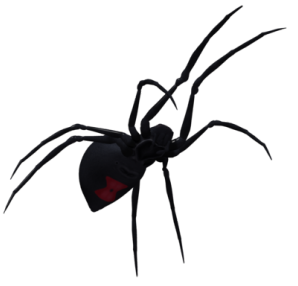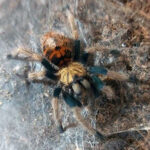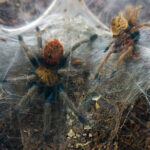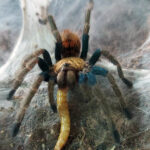Country of Origin: Venezuela
Natural Environment and Behavior:
Chromatopelma cyanopubescens, commonly known as the Green Bottle Blue Tarantula (GBB), is a vibrant and captivating species native to the arid regions of northern Venezuela. This tarantula is celebrated for its striking and iridescent coloration, featuring a metallic blue carapace, vibrant orange hairs on the abdomen, and contrasting greenish-blue legs.
In its natural habitat, C. cyanopubescens thrives in scrubland and savannah environments, where it showcases its burrowing instincts. This behavior remains evident in captivity, emphasizing the importance of providing a suitable substrate that allows for burrowing and digging.
Known for its docile temperament, the Green Bottle Blue Tarantula is a favorite among enthusiasts for its relatively calm demeanor. While they may exhibit defensive behaviors when threatened, they are generally less aggressive compared to some other tarantula species. Caution should still be exercised during handling to ensure the well-being of both the tarantula and the handler.
As opportunistic hunters, C. cyanopubescens preys on a variety of small invertebrates in the wild. In captivity, they are commonly fed live insects such as crickets, roaches, or mealworms. Their terrestrial lifestyle means they spend the majority of their time on the ground, occasionally venturing out for feeding or breeding activities.
The stunning coloration of the Green Bottle Blue Tarantula serves not only as a visual spectacle but may also function as a warning to potential predators. Replicating their natural behaviors in captivity involves providing an environment conducive to burrowing, ensuring a secure enclosure, and approaching handling with care to accommodate their temperament. Understanding and respecting the species’ natural behaviors contribute to a fulfilling and thriving existence for Chromatopelma cyanopubescens in captivity..
Longevity:
Females: up to 10 years, males: 3 to 6 years.
Size:
Up to 15cm.
Husbandry:
Keep at 60-70% humidity and 19-26°C, use a mix of coconut coir, peat moss, and vermiculite as substrate.
Enclosure Size:
12*12*12cm for spiderlings, 20*20*20cm for juveniles, and 30*30*30 cm or more for adults.



